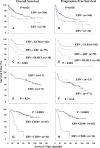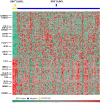EBV-positive diffuse large B-cell lymphoma of the elderly
- PMID: 23649469
- PMCID: PMC3779382
- DOI: 10.1182/blood-2013-03-489708
EBV-positive diffuse large B-cell lymphoma of the elderly
Abstract
Epstein-Barr virus (EBV) positive diffuse large B-cell lymphoma (DLBCL) of the elderly, initially described in 2003, is a provisional entity in the 2008 World Health Organization classification system and is defined as an EBV-positive monoclonal large B-cell proliferation that occurs in patients >50 years of age and in whom there is no known immunodeficiency or history of lymphoma. These tumors are more common in Asia but also occur in North America and Europe at a low frequency. These neoplasms exhibit a morphologic continuum, from polymorphous to monomorphous, but morphologic features do not correlate with prognosis as all patients have a clinically aggressive course. Most EBV-positive DLBCL of the elderly patients have an activated B-cell immunophenotype and are characterized by prominent nuclear factor-κB activation. Cytogenetic complexity is usually low. In this review, we comprehensively delineate the data emerging from analyses of EBV latency program, microRNA-mediated EBV viral oncogenesis, functional genomics of EBV and its biology, and differential diagnosis challenge for EBV-positive DLBCL of the elderly. It is hoped that the improved understanding of these tumors will lead to the development of novel therapeutic approaches, enhance the effectiveness of clinical trials, and improve prognosis.
Figures






Similar articles
-
Epstein-Barr virus (EBV) positive diffuse large B cell lymphoma of the elderly-experience of a single center from Turkey.Pathol Res Pract. 2013 Aug;209(8):471-8. doi: 10.1016/j.prp.2013.04.014. Epub 2013 May 9. Pathol Res Pract. 2013. PMID: 23726928
-
Epstein-Barr Virus-Positive Diffuse Large B-Cell Lymphoma: Is It Different between Over and Under 50 Years of Age?Asian Pac J Cancer Prev. 2016;17(4):2285-9. doi: 10.7314/apjcp.2016.17.4.2285. Asian Pac J Cancer Prev. 2016. PMID: 27221931
-
Epstein-barr virus-positive diffuse large B-cell lymphoma of the elderly: what we know so far.Oncologist. 2011;16(1):87-96. doi: 10.1634/theoncologist.2010-0213. Epub 2011 Jan 6. Oncologist. 2011. PMID: 21212426 Free PMC article. Review.
-
Epstein-Barr virus-positive diffuse large B-cell lymphomas of the elderly.Adv Anat Pathol. 2011 Sep;18(5):349-55. doi: 10.1097/PAP.0b013e318229bf08. Adv Anat Pathol. 2011. PMID: 21841405 Review.
-
Epstein-Barr Virus Infection of Cell Lines Derived from Diffuse Large B-Cell Lymphomas Alters MicroRNA Loading of the Ago2 Complex.J Virol. 2019 Jan 17;93(3):e01297-18. doi: 10.1128/JVI.01297-18. Print 2019 Feb 1. J Virol. 2019. PMID: 30429351 Free PMC article.
Cited by
-
EBV and human cancer.Exp Mol Med. 2015 Jan 23;47(1):e130. doi: 10.1038/emm.2014.109. Exp Mol Med. 2015. PMID: 25613727 Free PMC article. No abstract available.
-
EBV-driven B-cell lymphoproliferative disorders: from biology, classification and differential diagnosis to clinical management.Exp Mol Med. 2015 Jan 23;47(1):e132. doi: 10.1038/emm.2014.82. Exp Mol Med. 2015. PMID: 25613729 Free PMC article. Review.
-
EBV microRNA-BHRF1-2-5p targets the 3'UTR of immune checkpoint ligands PD-L1 and PD-L2.Blood. 2019 Dec 19;134(25):2261-2270. doi: 10.1182/blood.2019000889. Blood. 2019. PMID: 31856276 Free PMC article.
-
Targeted Therapy for EBV-Associated B-cell Neoplasms.Mol Cancer Res. 2019 Apr;17(4):839-844. doi: 10.1158/1541-7786.MCR-18-0924. Epub 2018 Nov 28. Mol Cancer Res. 2019. PMID: 30487243 Free PMC article.
-
Molecular profiling of EBV associated diffuse large B-cell lymphoma.Leukemia. 2023 Mar;37(3):670-679. doi: 10.1038/s41375-022-01804-w. Epub 2023 Jan 5. Leukemia. 2023. PMID: 36604606 Free PMC article.
References
-
- Nakamura S, Jaffe ES, Swerdlow SH. eds. EBV positive diffuse large B-cell lymphoma of the elderly. In: Swerdlow SH, Campo E, Harris NL, et al., eds. WHO Classification of Tumours of Haematopoietic and Lymphoid Tissues. Lyon, France: International Agency for Research on Cancer; 2008.
-
- Oyama T, Ichimura K, Suzuki R, et al. Senile EBV+ B-cell lymphoproliferative disorders: a clinicopathologic study of 22 patients. Am J Surg Pathol. 2003;27(1):16–26. - PubMed
-
- Beltran BE, Morales D, Quiñones P, Medeiros LJ, Miranda RN, Castillo JJ. EBV-positive diffuse large b-cell lymphoma in young immunocompetent individuals. Clin Lymphoma Myeloma Leuk. 2011;11(6):512–516. - PubMed
-
- Beltran BE, Castillo JJ, Morales D, et al. EBV-positive diffuse large B-cell lymphoma of the elderly: a case series from Peru. Am J Hematol. 2011;86(8):663–667. - PubMed
-
- Gibson SE, Hsi ED. Epstein-Barr virus-positive B-cell lymphoma of the elderly at a United States tertiary medical center: an uncommon aggressive lymphoma with a nongerminal center B-cell phenotype. Hum Pathol. 2009;40(5):653–661. - PubMed
Publication types
MeSH terms
Substances
Grants and funding
LinkOut - more resources
Full Text Sources
Other Literature Sources

